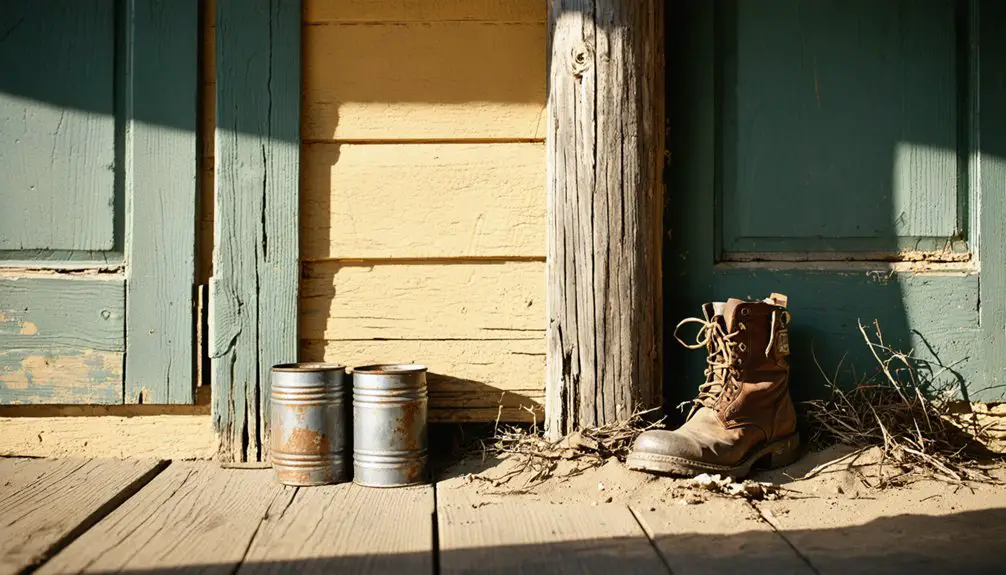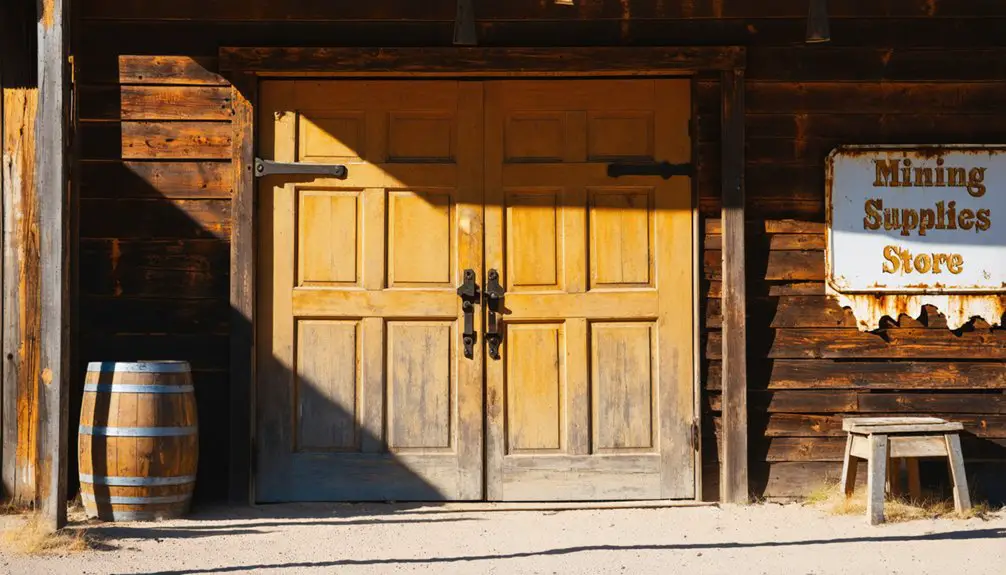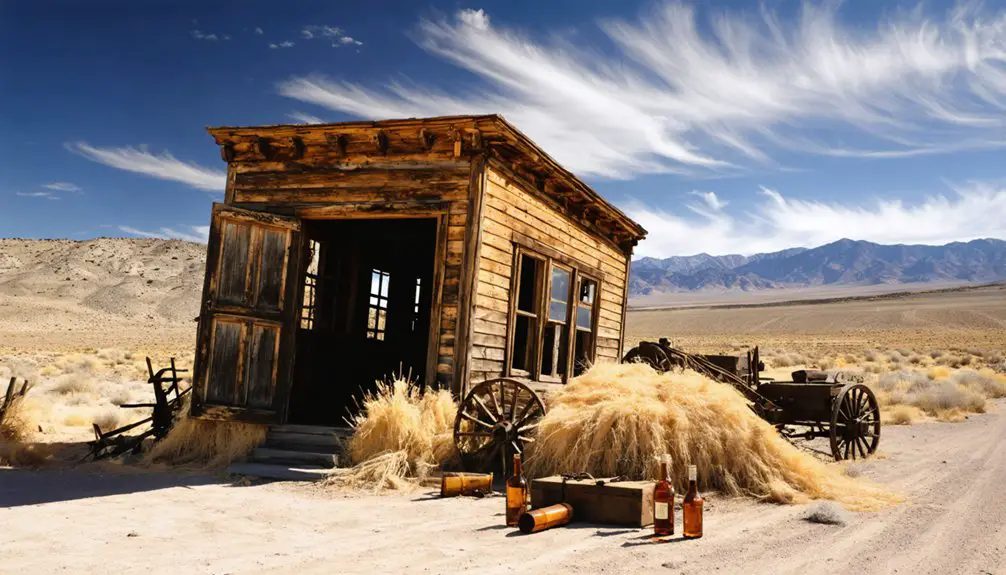You’ll discover Mule Lick in northern Lander County, Nevada, where gold mining operations thrived in the late 1990s. The site processed over 8.2 million tonnes of gold-bearing ore during its peak years, employing advanced mining techniques and rail transport to maximize production. While the town once supported 3,000 residents with 25 saloons and two hotels, it became deserted by 1916 after mineral depletion. Today, you can explore remnants of cabins, mine shafts, and the historic Pioneer Saloon to uncover its frontier legacy.
Key Takeaways
- Mule Lick was a Nevada mining town that peaked with 3,000 residents in the 1880s before becoming abandoned by 1916.
- The town’s mining operations yielded 8.2 million tonnes of gold-bearing ore during peak production in the late 1990s.
- Historic structures include the Pioneer Saloon (1913), Tom Kelly’s Bottle House, and remnants of mining shafts with timber supports.
- Located 4 miles west of Beatty, Nevada, the ghost town is accessible via State Route 374 and U.S. Route 95.
- The town’s decline began after the Panic of 1907, when investors withdrew capital and mineral deposits became depleted.
The Rise of a Mining Frontier
While many Nevada mining districts emerged during the 19th-century silver rush, Mule Lick’s story began in the late 1990s as part of the state’s modern gold mining expansion.
You’ll find this low-sulfidation epithermal deposit nestled in northern Lander County, where geological surveys revealed substantial gold-silver reserves within volcanic rocks dating back 15.6 million years.
Despite strict mining regulations, developers capitalized on an estimated 9 to 15.9 million short tons of ore, averaging 0.09 to 0.112 ounces of gold per ton. The ore fluids were dilute and reduced, contributing to the unique mineralization patterns at the site. Goldfields Mining Company made the initial discovery in 1986, marking the beginning of modern exploration at the site.
Even with regulatory hurdles, the mine’s rich deposits yielded millions of tons containing substantial gold concentrations worth extracting.
The site’s volcanic framework, controlled by high-angle faults and breccia zones, proved ideal for open-pit mining operations.
At 6,496 feet elevation, Mule Lick’s success reinforced Nevada’s position as America’s premier gold-producing state, building on the region’s rich mining heritage.
Life in Mule Lick’s Golden Era
The geological riches that drew miners to Mule Lick soon gave rise to a bustling frontier community of up to 3,000 residents during the 1880s.
You’d find a town pulsing with energy, where 25 saloons and two hotels served a diverse mix of miners, families, and travelers. The community dynamics reflected both cooperation and chaos – while residents banded together to survive harsh winters and isolation, the lack of formal law enforcement led to frequent shootouts. Like nearby Pioche, where 72 violent deaths occurred before the first natural one, Mule Lick had its share of deadly conflicts.
Daily life demanded grit. You’d need to navigate extreme weather, limited water access, and periods of isolation when snow closed the roads. The town’s dilapidated structures still stand today as silent witnesses to this harsh frontier life.
Despite these challenges, the town’s survival strategies included building a self-sustaining ecosystem of businesses, from grocery stores to mining supply shops, all supported by critical railroad connections.
Mining Operations and Economic Impact
You’ll find Mule Lick’s peak production years centered around the late 1990s, when its open-pit operations processed approximately 8.2 million tonnes of gold-bearing ore using state-of-the-art crushing and heap leach facilities.
Similar to Virginia City’s square set timbering innovations, the mine employed advanced structural support systems to ensure safe extraction. The Twenty Mule Team transport system that revolutionized borax mining served as inspiration for developing efficient hauling methods at Mule Lick. The mine’s strategic location and infrastructure allowed for efficient trucking of ore to the Lone Tree processing facility, making the modest gold grades of around 0.09 ounces per ton economically viable.
Advanced mining equipment and selective extraction methods focused on high-grade zones within the volcanic host rocks, maximizing the recovery of the estimated 45 metric tonnes of contained gold.
Mining Technology and Equipment
Mining operations in Mule Lick relied on a diverse array of technologies and equipment that evolved from simple manual tools to sophisticated machinery.
You’ll find evidence of this progression in the underground maps that guided precise tunneling operations, while drilling techniques and blasting methods carved pathways through the earth.
When tunnels became unstable, miners employed remote loaders to safely enter fractured areas, followed by shotcrete application and rock bolts for reinforcement.
Today’s mining automation represents a stark contrast to the site’s early days of Mexican arrastras and Long Toms.
Modern electric machinery has replaced the mules that once hauled ore through treacherous terrain.
Yet despite these advances, you can still trace Mule Lick’s technological heritage from its humble beginnings to its final days of automated efficiency.
The harsh underground conditions meant equipment maintenance was critical, with machines operating in rugged, compact environments that severely tested their durability.
Early miners used gravity-powered hammers in stamp mills to crush ore into finer material for more efficient gold extraction.
Peak Production Years
During Mule Lick’s most productive era, six small deposits yielded approximately 8.2 million tons of high-grade ore, averaging 3.81 grams of gold per tonne. The peak production aligned with Nevada’s broader gold and silver rush of the late 1800s, when mining methods focused on extracting precious metals from epithermal deposits formed 16.4 to 15.6 million years ago. Similar to the Carlin gold discovery in 1962, these deposits proved to be highly lucrative for the region.
Key production highlights include:
- Ore extraction targeted basalt-andesite zones rich in gold and silver
- Output rivaled Comstock Lode operations, which produced over $110 million in precious metals
- Mining operations supported extensive local employment and economic growth
You’ll find that Mule Lick’s success contributed considerably to Nevada’s reputation as a dominant precious metals producer, while creating essential infrastructure and transportation networks that shaped the region’s development.
Railroad Transport Impact
As rail transport supplanted traditional twenty-mule teams in the late 1800s, Mule Lick’s mining operations underwent a dramatic transformation in both scale and efficiency.
You’ll find that railroad freight revolutionized mining logistics, allowing mines to ship greater volumes of ore while reducing transport times and costs compared to the old mule trains that carried just 300 pounds per animal.
The railroad’s impact extended beyond just moving minerals. Mexican mules were once the backbone of transport, with their strength and endurance making them superior to American mules.
It’s what attracted new investment to the region and helped diversify the local economy.
While mule teams could only operate seasonally on limited trails, the rail network provided year-round reliable transport that connected Mule Lick’s mining output to national markets.
This improved accessibility spurred exploration of new mining districts and supported the growth of retail and service industries in surrounding communities.
Daily Life and Social Scene

In Mule Lick’s lively saloons, you’d find miners gathering after their shifts to drink, gamble, and share stories about their latest ore discoveries.
You could join card games, listen to impromptu musical performances, or catch up on local gossip at these essential social hubs that served as the town’s primary meeting places.
The mix of different cultures and backgrounds created a dynamic nightlife scene, where traveling performers occasionally stopped to entertain the hardworking residents who sought relief from their grueling days in the mines.
Saloons and Social Gatherings
The Pioneer Saloon stood as the beating heart of Mule Lick‘s social scene, drawing both locals and travelers to its lively atmosphere since 1913.
Beyond just drinks, the saloon culture fostered essential community gatherings where miners and residents could escape frontier isolation, exchange news, and forge crucial connections.
You’ll find these fascinating elements that made the Pioneer Saloon a cornerstone of local life:
- Original stamped tin walls and ceiling that still stand today, complete with historic bullet holes from a deadly 1915 card game
- Regular social events including card games, gambling, and communal meals
- A hub for business dealings, information sharing, and entertainment in a town that once bustled with 800 residents
The saloon remains open, letting you experience the authentic Old West ambiance that defined early Nevada mining communities.
Mining Life After Dark
Mining operations transformed drastically after sunset, with round-the-clock shifts keeping Mule Lick’s tunnels alive throughout the night.
You’d find miners maneuvering the darkened passageways by lantern light, while their trusted mules rested in illuminated underground stables nearby. These animals often proved essential, sensing nighttime hazards like flooding before humans could detect them.
Beyond the tunnels, miner camaraderie flourished in evening gatherings. You’d see workers congregating in homes and communal spaces, sharing meals and swapping stories of their underground adventures.
Card games, music, and occasional traveling performances provided entertainment, while some miners caught up on news by lamplight.
Despite the challenges of shift work, families adapted their routines, with women maintaining crucial social networks during evening hours as children adjusted their schedules to match their fathers’ shifts.
Transportation and Access Routes
Access to Mule Lick involves multiple transportation routes, with State Route 374 and U.S. Route 95 serving as your primary arteries to reach this remote ghost town.
You’ll find it approximately 4 miles west of Beatty, Nevada, though road conditions can present access challenges depending on seasonal weather.
To successfully navigate to Mule Lick, you’ll want to:
- Start from Las Vegas, heading northwest about 120 miles on US-95
- Transfer to State Route 374, watching for unmarked dirt roads
- Prepare for high-clearance driving on unpaved trails, especially near mining ruins
Your journey follows historic paths once used for ore transport, though many original routes have deteriorated.
Modern GPS navigation proves essential, as traditional road signs are limited.
Spring and fall offer the most favorable conditions for exploring these desert and mountain trails.
The Decline and Abandonment

Once profitable mineral deposits began to dwindle in the early 1900s, Mule Lick’s fate was sealed as a boom-and-bust mining town. The economic consequences were swift and severe.
As mining operations became unprofitable due to depleted high-grade ore, investors withdrew their capital, especially after the Panic of 1907.
The resulting population decline transformed Mule Lick into a ghost town by 1916. You’d have witnessed mass exodus as miners and their families sought opportunities elsewhere, leaving behind empty buildings and dormant mines.
Key institutions – banks, newspapers, and the post office – shuttered their doors. The harsh environment and isolation only hastened the town’s demise.
Locals salvaged building materials for use in neighboring communities, and by the 1920s, Mule Lick stood virtually empty, its remains a reflection of Nevada’s volatile mining era.
Surviving Structures and Artifacts
Remnants of Mule Lick’s heyday dot the desert landscape, offering a glimpse into its vibrant past.
You’ll find surviving cabins constructed from rubble, adobe, wood, and stone, with some dating back to 1906. The town’s cultural artifacts paint a picture of frontier ingenuity and determination.
Here’s what you’ll discover as you explore:
- Mine shafts with timber-supported entrances and scattered headframes marking former mining sites
- A historic cemetery where visitors leave offerings at notable graves, including symbolic tributes to “Mona Bell”
- Tom Kelly’s remarkable Bottle House, built from over 50,000 glass bottles and maintained as a tribute to resourceful construction
Among the ruins, you’ll spot mill foundations, mining tools, and household items that tell the story of daily life in this once-thriving community.
Exploring Mule Lick Today

Today’s visitors to Mule Lick encounter a remote desert landscape where nature has gradually reclaimed the historic mining settlement.
You’ll need to plan your trip carefully, as the site lacks modern amenities and marked trails. The best time to visit is from late spring to early fall when weather conditions are most favorable.
Your visitor preparedness should include plenty of water, navigation tools, and a reliable vehicle suitable for rough terrain.
The ghost town’s isolation and absence of commercial development create an authentic atmosphere perfect for exploring natural landscapes and photographing historic ruins.
While guided tours are limited, you’re free to discover the site independently.
Remember to follow “leave no trace” principles and respect any land management restrictions to help preserve this piece of Nevada’s mining heritage.
Frequently Asked Questions
Were Any Notable Outlaws or Lawmen Associated With Mule Lick?
You won’t find any documented outlaw legends or lawman tales tied to this location – historical records don’t show any notable criminal figures or law enforcement personalities operating there.
What Native American Tribes Originally Inhabited the Area Around Mule Lick?
Like an ancient GPS would show, you’d find the Northern Paiute Tribe and Western Shoshone Tribe were the primary inhabitants, maintaining deep cultural connections to this rugged Great Basin territory.
Did Any Major Fires or Natural Disasters Contribute to Mule Lick’s Decline?
You won’t find evidence of fire damage or disaster impact contributing to Mule Lick’s decline. Historical records show the town’s abandonment came from economic factors and mining depletion rather than catastrophic events.
Are There Any Documented Paranormal Activities or Ghost Stories From Mule Lick?
Despite legends from nearby ghost towns, you won’t find documented ghost sightings or haunted locations in Mule Lick. While Nevada’s mining towns often attract paranormal tales, no verified supernatural reports exist here.
What Happened to the Cemetery and Are There Maintained Grave Sites?
You won’t find maintained grave sites today, as there’s no documented cemetery upkeep. Like other ghost town burial grounds, any graves that existed are likely overgrown and unmarked through decades of abandonment.
References
- https://www.youtube.com/watch?v=KfdCMac0zak
- https://www.youtube.com/watch?v=znYWZIDO6bA
- https://www.youtube.com/watch?v=9EZmsAyiXI0
- https://nevadamagazine.com/issue/winter-2024-2025/25048/
- https://nvtami.com/2025/06/25/lincoln-county-ghost-town-trip/
- https://pubs.usgs.gov/publication/70025985
- https://westernmininghistory.com/mine-detail/10310546/
- https://nbmg.unr.edu/mining/MiningHistory.html
- http://www.parenvironmental.com/assets/articles/Of-Mines-and-Mules-A-History-of-Daggett.pdf
- https://petticoatsandpistols.com/2018/07/17/mules-in-mines-julie-lence-shares-her-research/



